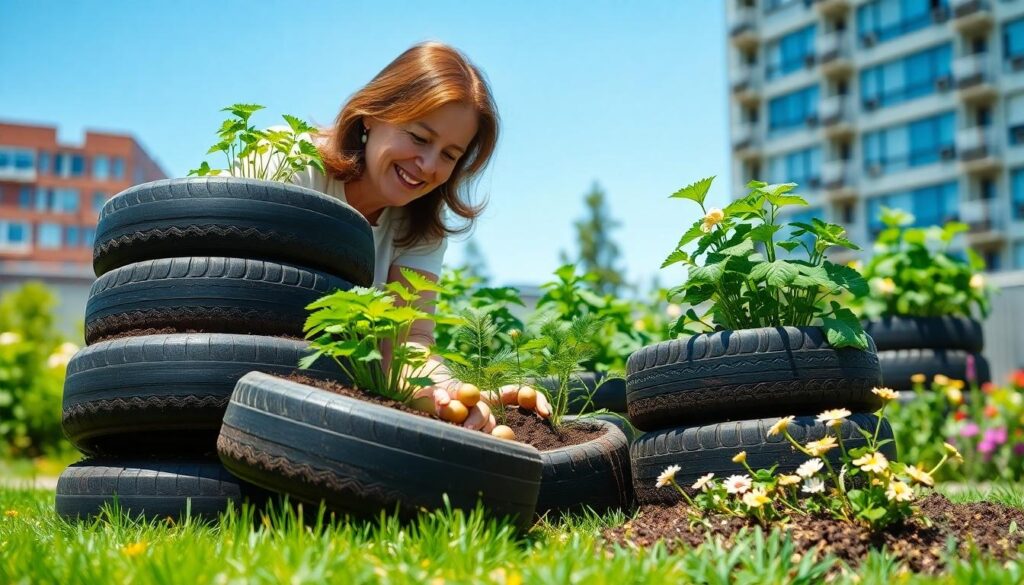Growing potatoes in tires is one of the most ingenious gardening hacks we’ve discovered for maximizing your harvest in minimal space. This method lets you stack tires as your potato plants grow, continuously adding soil and dramatically increasing your yield. It’s perfect for urban gardeners, homesteaders with limited space, or anyone looking to simplify their potato-growing process.
Why Growing Potatoes in Tires Is a Smart Gardening Hack
Growing potatoes in tires offers several important advantages that make it a brilliant solution for gardeners of all experience levels. This vertical gardening technique maximizes your harvest while minimizing the space required, making it perfect for urban environments or small yards. Stacking tires creates an expandable growing container that allows for continuous hilling without the need for extensive digging when harvest time arrives.
The cost effectiveness of this method can’t be overlooked, as old tires are often available for free from tire shops or auto repair centers that would otherwise pay to dispose of them. Recycling these tires gives them new purpose while keeping them out of landfills, making this an environmentally friendly gardening approach. The dark color of rubber tires also absorbs heat, creating a warmer growing environment that can extend your growing season in cooler climates.
Accessibility stands out as another major benefit, as harvesting potatoes from tires doesn’t require the back-breaking digging associated with traditional methods. Simply remove the top tire when the plants have died back, and collect the potatoes nestled in the soil. The modular nature of the tire system allows you to add more growing space vertically as plants develop, rather than spreading outward into valuable garden real estate.
Pest management becomes easier too, as the elevated growing system creates a barrier against many ground-dwelling pests that typically damage potato crops. Water efficiency improves with this method because the enclosed tire structure helps retain moisture while still allowing excess water to drain through the bottom, creating ideal growing conditions for potato plants.
Essential Supplies Needed for the Tire Potato Garden

Before starting your tire potato garden, gathering the right materials will ensure a successful harvest. Here’s everything you’ll need to get growing:
- Tires: 3-5 standard car tires
- Seed potatoes: Certified disease-free varieties
- Soil: Well-draining mixture with compost
- Tools: Gloves, shovel, and watering can
Selecting the Right Type of Tires
Standard car tires work best for potato growing, but not all tires are created equal. Avoid using tires with visible chemical leaks or exposed metallic belts as these can potentially leach unwanted substances into your soil. We recommend thoroughly cleaning your tires before use to remove any road debris or contaminants. Fresh tires without heavy wear are ideal, though recycled tires can be perfectly suitable after proper cleaning. The dark rubber material serves a practical purpose by absorbing heat from the sun, creating a warmer growing environment that can extend your potato growing season, especially in cooler climates.
Quality Seed Potatoes and Soil Requirements
Selecting high-quality seed potatoes is crucial for a bountiful harvest. Choose certified disease-resistant varieties like Kipfler or Russet to minimize potential growing problems. Prepare your seed potatoes by cutting them into 2-inch pieces, ensuring each segment has at least two “eyes” from which new plants will sprout.
The soil mixture you use directly impacts your potato yield. Create an optimal growing medium by mixing compost, coffee grounds, or rotted straw to provide essential nutrients. Your soil pH should ideally fall between 5.0 and 6.0 for potatoes to thrive. A well-draining soil prevents waterlogging while retaining enough moisture for consistent growth. Leaf mold also makes an excellent addition to your soil mix as it improves soil structure while providing slow-release nutrients for your developing potato plants.
Step-by-Step Guide to Setting Up Your Tire Potato Tower
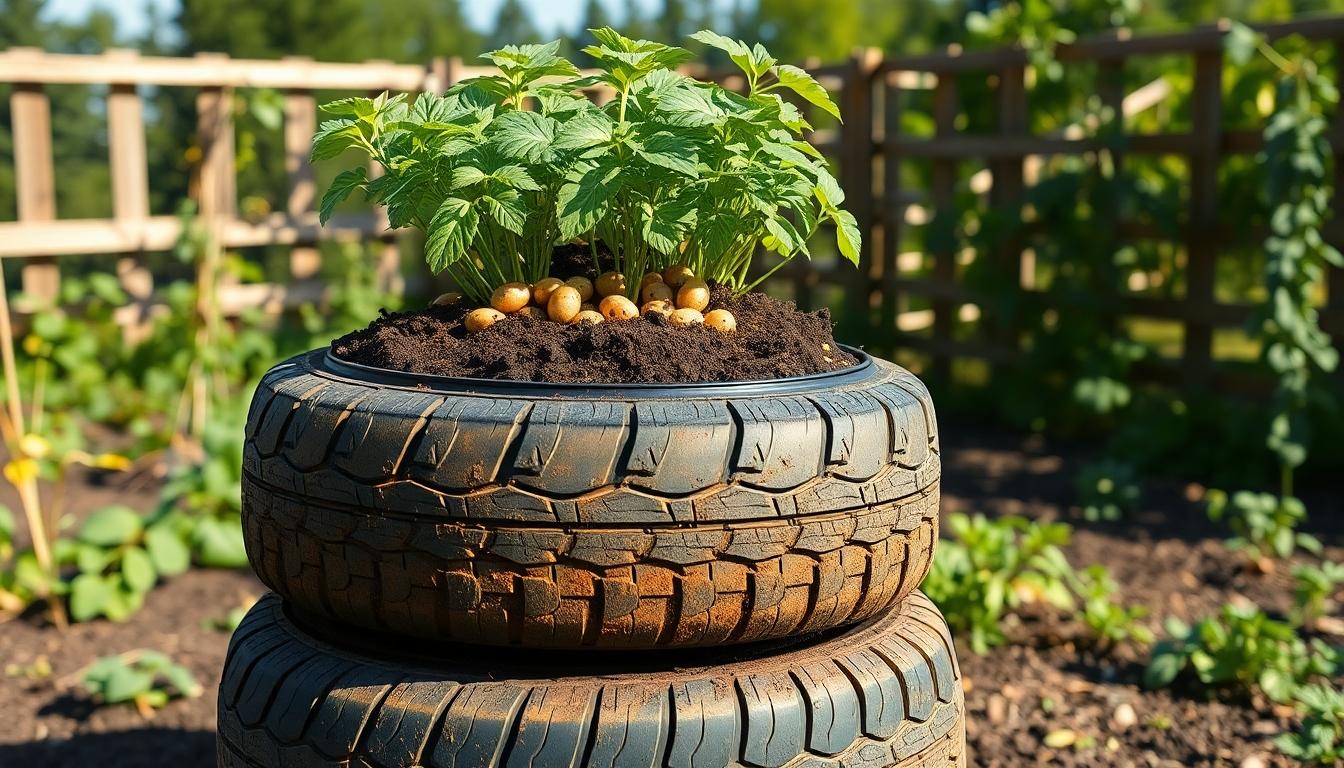
Now that you’ve gathered all your supplies, let’s jump into the actual process of creating your potato tower using recycled tires.
Preparing the Base Location
- Select a Sunny Spot: Choose a location that receives full sun throughout the day, as potatoes need at least 6-8 hours of direct sunlight to develop properly.
- Gather Materials: Collect your clean old car tires, seed potatoes, soil mixture, and organic matter like compost or rotted straw before starting the assembly process.
- Prepare the Tires: Ensure your tires are thoroughly cleaned to remove any road debris, chemicals, or contaminants that might affect your potato growth.
Initial Planting Techniques
- Layer the Base Tire: Fill the bottom tire with a 50/50 mix of soil and organic matter to create a nutrient-rich foundation. Position 2-3 seed potatoes evenly spaced in this bottom layer, with their eyes facing upward.
- Cover the Seed Potatoes: Add more of your soil and organic matter mixture on top of the seed potatoes, leaving approximately one inch of space at the top of the tire. Water thoroughly but gently to avoid disturbing the newly planted potatoes.
Stacking Tires
- Allow Plants to Grow: Monitor your potato plants until they reach about 6 inches above the soil level, which typically takes 2-3 weeks depending on growing conditions.
- Fill the Additional Tire: Place another clean tire directly on top of the base tire once plants have reached sufficient height. Add your soil mixture around the growing stems, leaving about 2 inches of foliage exposed to continue photosynthesis.
- Repeat as Needed: Continue this stacking process as your plants grow taller, adding a new tire and soil each time until you reach a practical height of 3-5 tires for optimal yield and stability.
Harvest
- Wait for Maturity: Allow your potato plants to fully mature, which you’ll recognize when the foliage begins to yellow and die back naturally, typically 70-120 days after planting depending on the variety.
- Harvest Potatoes: Dismantle your tire tower one level at a time, carefully removing each tire to reveal your potato harvest. Start from the top and work your way down, collecting potatoes as you go.
Adding Tires and Soil as Potatoes Grow
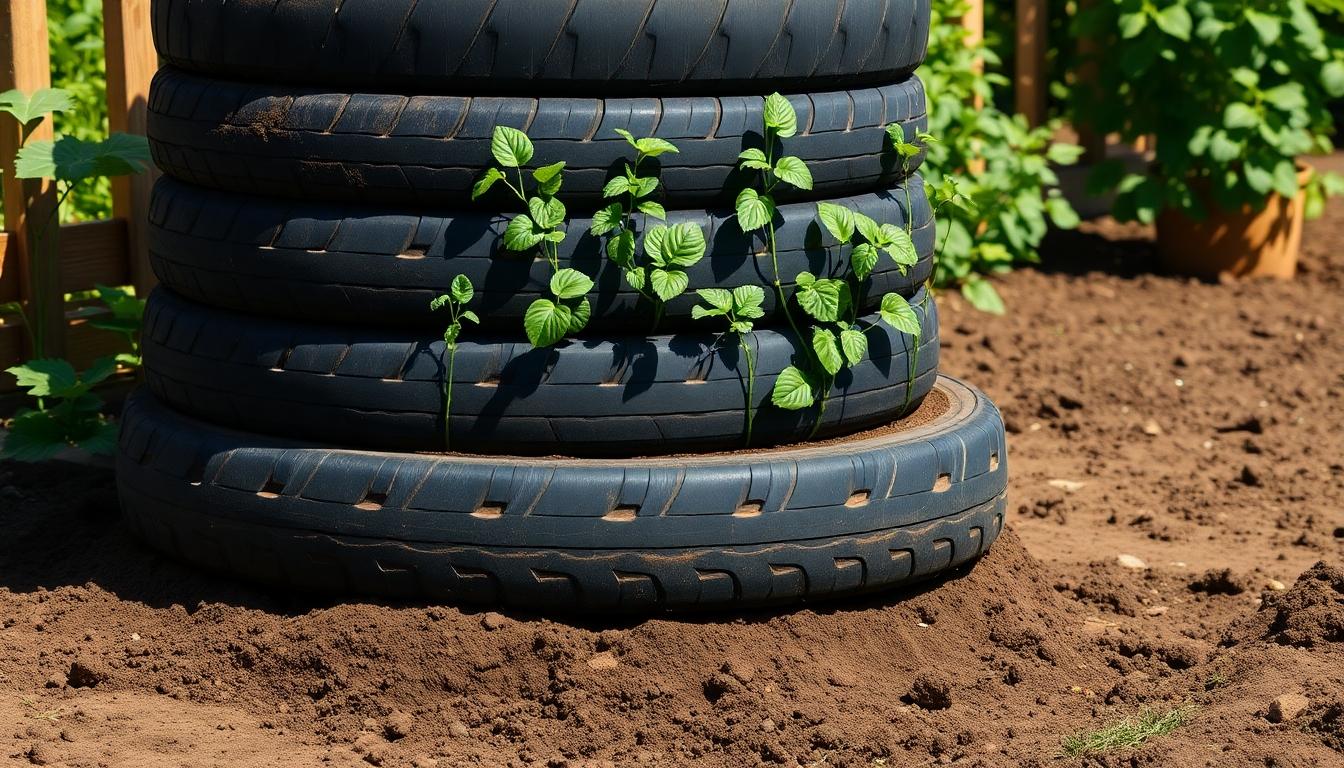
Growing potatoes in tires is all about timing the addition of new tires and soil as your plants develop. This vertical growing method maximizes your harvest while making the most of limited space.
When and How to Stack Additional Tires
Watch for your potato plants to reach about 4-6 inches above the soil surface before adding the next tire. This height serves as the perfect indicator that your plants are ready for the next stage of growth. Simply place a new tire directly on top of your existing stack when the plants have reached this height. After positioning the new tire, fill it with fresh soil or rich compost, leaving approximately 2 inches of the plant foliage exposed above the soil line. Continue this stacking process as your plants grow taller, typically reaching a practical height of two to three tires for most home gardeners. The progressive stacking encourages potatoes to form along the buried stems, dramatically increasing your overall yield from the same footprint.
Proper Soil Layering Methods
Create a nutrient-rich environment by using a diverse soil mixture that includes garden soil, compost, leaf mold, lawn clippings, or even coffee grounds. These organic materials provide essential nutrients that potatoes need for optimal development. Fill each tire to approximately half its depth initially, which gives you room to add more soil as the plants continue to grow upward. Ensure your tire tower has good drainage, as potatoes strongly dislike waterlogged conditions that can lead to rot. Position your tire stack in a location that receives full sunlight to promote healthy growth and robust tuber development. Maintain soil moisture without saturating it, and consistently mound additional soil or straw around emerging plants to encourage more potato formation along the stems. This layering technique creates multiple levels for tubers to develop, eventually resulting in a substantially larger harvest from your vertical potato tower.
Watering and Maintenance Tips for Tire Potato Gardens
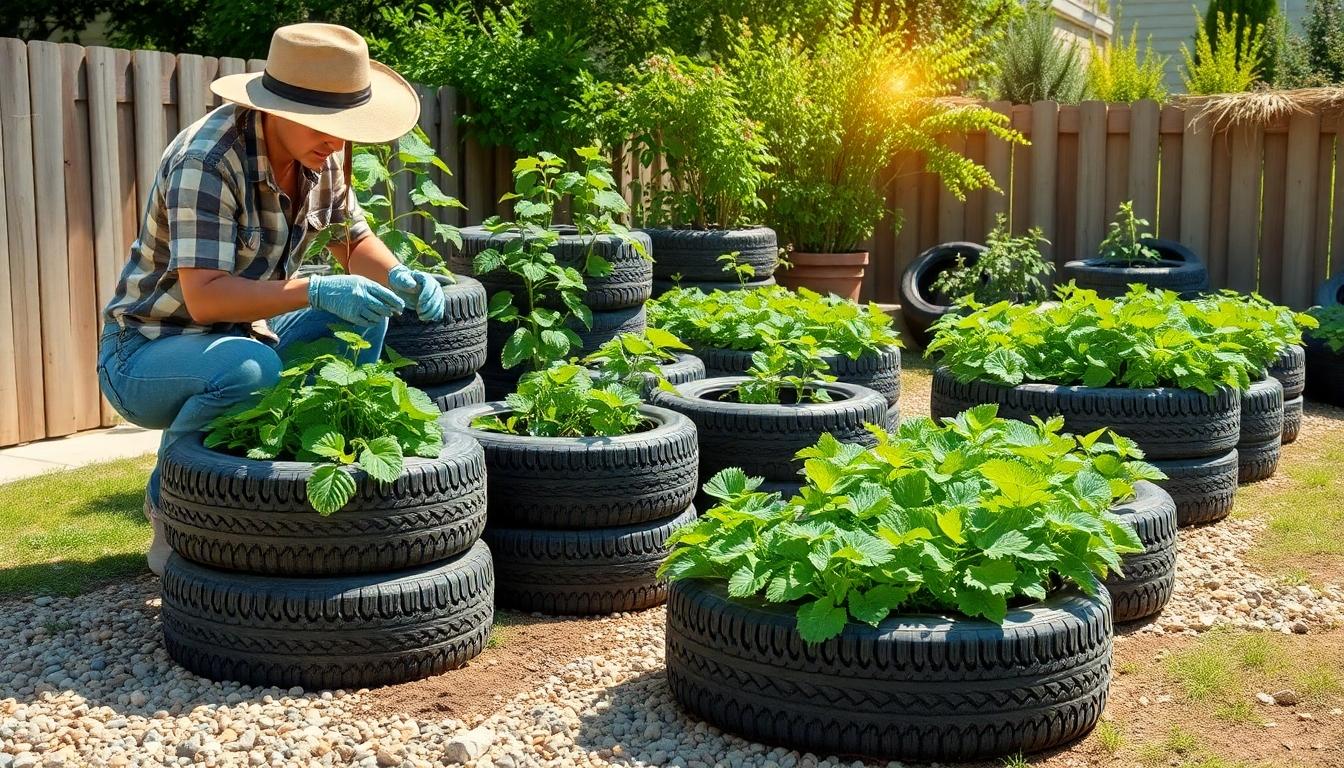
Proper maintenance ensures your tire potato garden thrives throughout the growing season. Here’s how to care for your potato tower to maximize your harvest.
Irrigation Best Practices
Consistent moisture is crucial for potato development in tire gardens. Water your potato towers deeply when the top 1-2 inches of soil feel dry, typically 1-2 times weekly depending on your climate. Always ensure proper drainage by placing tires on well-draining ground or gravel to prevent waterlogged soil which can cause rot.
When adding a new tire layer, thoroughly water the fresh soil to help it settle around the emerging stems. This creates good soil contact and encourages new tuber formation. Consider adding a layer of straw or lawn clippings to the top of your potato tower to retain moisture and reduce evaporation during hot weather. This mulching technique can significantly decrease watering frequency while maintaining the consistent moisture potatoes need.
Pest Control Answers
Protecting your tire potato garden from pests starts with preventative measures. Line the bottom tire with wire mesh to create an effective barrier against burrowing rodents that might damage your crop from below. Companion planting offers natural protection – marigolds or basil planted nearby will repel common potato pests like aphids and beetles.
For active infestations, organic treatments work well in tire potato systems. Apply neem oil or diatomaceous earth to combat potato beetles and leafhoppers without introducing harmful chemicals. Make inspecting your plants part of your regular maintenance routine by checking the undersides of leaves for pests and manually removing any egg clusters or infested foliage you discover.
Maintenance Guidelines
Limit your tire stacks to three tires to prevent soil compaction and ensure plant stability as they grow taller. Soil quality directly impacts yield, so use a nutrient-rich mix of compost, damp earth, and organic matter like coffee grounds to feed your potatoes throughout their growing cycle.
Harvesting from tire gardens is remarkably simple compared to traditional methods. Wait until the foliage yellows, typically 10-12 weeks after your final tire stacking, then gently remove the tires one by one. This approach allows you to harvest mature potatoes from each layer without disturbing the entire system, giving you continuous access to your crop without the extensive digging required in conventional potato beds.
Harvesting Potatoes from Your Tire Tower
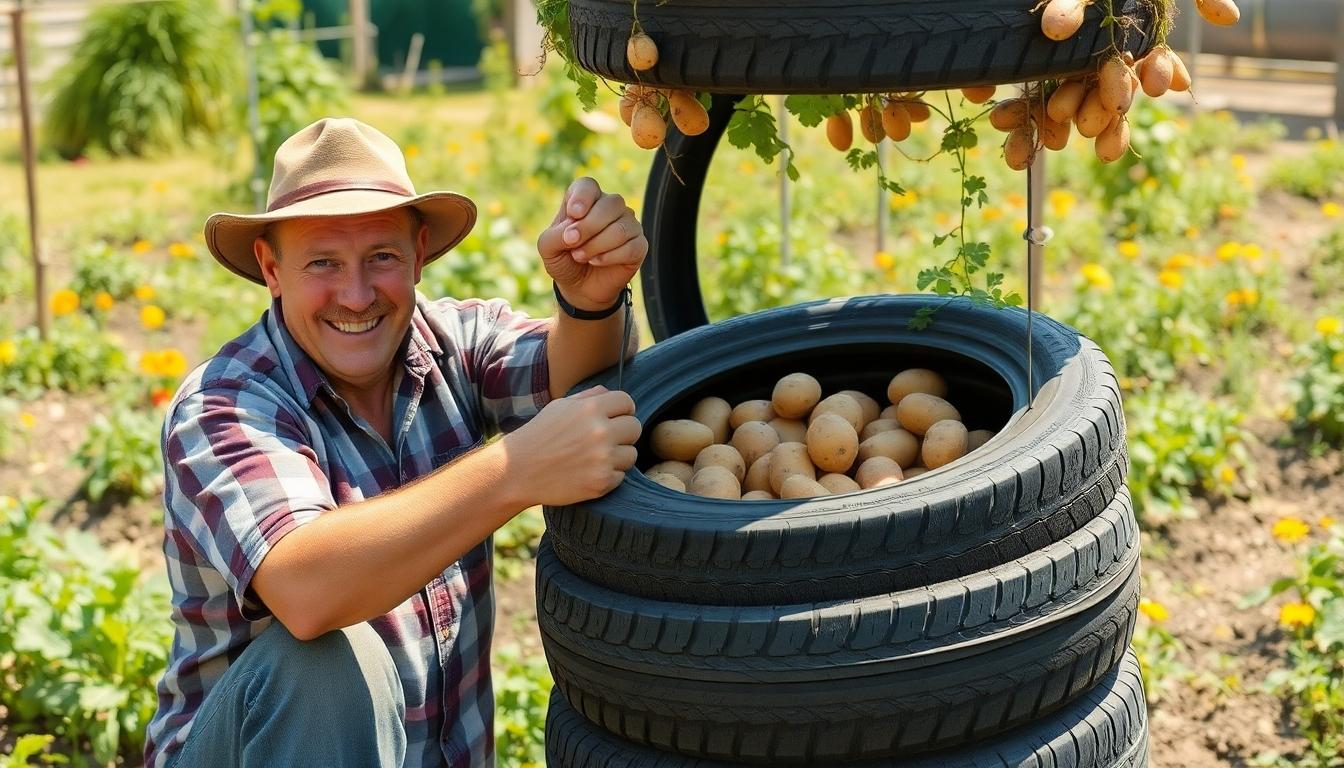
After weeks of carefully tending to your potato tire tower, it’s time for the rewarding part – harvesting your homegrown potatoes. This unique growing method makes harvesting significantly easier than traditional in-ground planting.
Signs Your Potatoes Are Ready to Harvest
Timing your harvest correctly ensures the best quality and yield from your tire potato tower. Yellowing or browning foliage serves as the primary indicator that your potatoes are ready to be harvested. This natural color change typically occurs after the plants have completed their flowering cycle and seed production. Mature potato plants naturally begin to die back, signaling that the tubers below have reached their full potential. We recommend waiting until at least 50% of the foliage has changed color before planning your harvest day. Tuber size also matters – gently feel around the soil in the top tire to check if the potatoes have reached a substantial size for consumption without disturbing the entire structure.
Proper Harvesting Techniques
Harvesting potatoes from your tire tower requires a methodical approach to maximize your yield. Start by carefully removing the top tire to access the first layer of potatoes. Gently brush away the soil to reveal the tubers, taking care not to damage them with hasty movements. For subsequent layers, continue disassembling the tower one tire at a time, working your way downward. We recommend using a garden fork to delicately dig around the tubers, keeping the fork a safe distance from the potatoes to avoid puncturing them. This layered harvesting approach allows you to collect potatoes of different sizes throughout your tower. Smaller potatoes found in the upper tires can be harvested for immediate use, while larger potatoes from lower sections might be better suited for storage. Remember that potatoes in the bottom tire may develop earlier than those in upper sections, so monitor them carefully to prevent rot before the entire tower is ready for harvest.
Common Problems and Troubleshooting
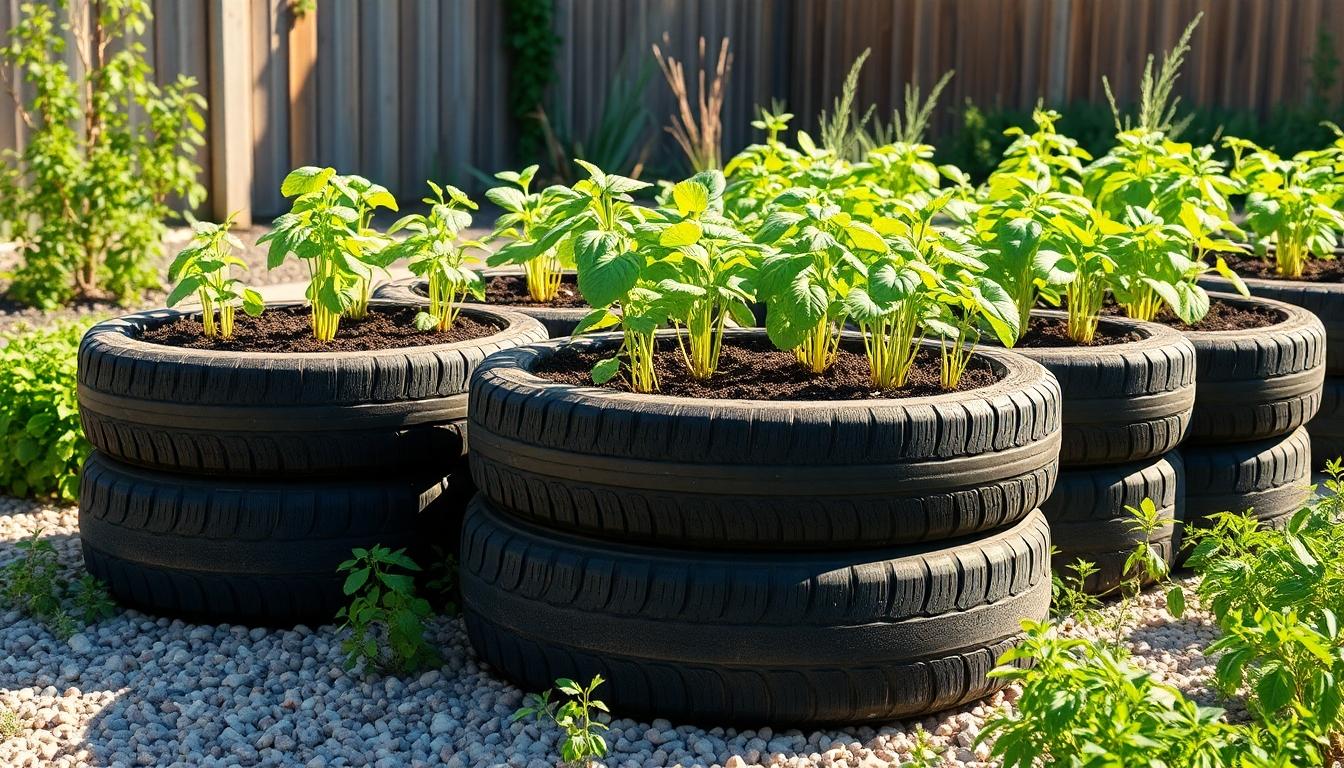
Growing potatoes in tires can present unique challenges that require exact answers. Let’s examine common issues gardeners face with this method and how to overcome them.
Poor Drainage Issues
Poor drainage is one of the most frequent problems with tire potato towers. Water trapped inside stacked tires leads to potato rot and failed crops. We recommend placing your tire setup on a layer of gravel or boards with drilled holes to ensure adequate drainage. Elevating the bottom tire slightly can also prevent water accumulation and reduce the risk of root rot.
Pest Management
Rodents and other pests may intrude into your potato tires, especially when placed directly on soil. To prevent this, consider elevating your tires or installing hardware cloth underneath the bottom tire. This creates a protective barrier while still allowing for proper drainage and root development. Common pests can be further deterred by companion planting with pest-repellent herbs around your tire tower.
Structural Challenges
Tire towers become increasingly unstable beyond three or four layers. We’ve found that limiting your stack to 3-4 tires provides optimal stability while still maximizing growing space. Taller stacks risk toppling over, especially in windy conditions or when the soil becomes waterlogged. Using wider tires at the base can provide additional structural support for taller arrangements.
Soil Compaction Problems
Compacted soil inhibits tuber development and reduces overall yield. Using a lightweight, nutrient-rich soil mix prevents this issue. We recommend combining garden soil with compost and straw to create an airy medium that potatoes thrive in. This lighter mixture allows tubers to form easily while maintaining adequate moisture retention.
Dealing with Potato Diseases
Late blight poses a serious threat to potato plants, appearing as dark lesions on leaves that spread rapidly. Remove infected plants immediately and avoid overhead watering to prevent spore spread. Scab disease causes unsightly lesions on tuber surfaces, making potatoes less appealing but still edible. Maintain soil pH below 5.2 using sulfur amendments and avoid applying fresh manure to prevent scab development. Fusarium wilt manifests as yellowing foliage that gradually wilts even though adequate watering. Proper crop rotation and using certified disease-free seed potatoes are your best defenses against fusarium.
Preventing Tire Leaching Concerns
Chemical leaching from tires lacks definitive scientific consensus, but some evidence suggests tires may release trace compounds like zinc into the soil. Using weathered or aged tires significantly reduces this risk as most compounds leach out during initial exposure to the elements. We suggest lining tire interiors with food-safe plastic as an additional precaution to create a barrier between the rubber and your growing medium. Applying acrylic paint to the interior surfaces of tires also helps minimize potential leaching while adding visual appeal to your garden. When possible, prioritize tires marked as “non-toxic” or “food-grade” if you’re particularly concerned about chemical exposure.
Creative Design Ideas for Tire Potato Gardens
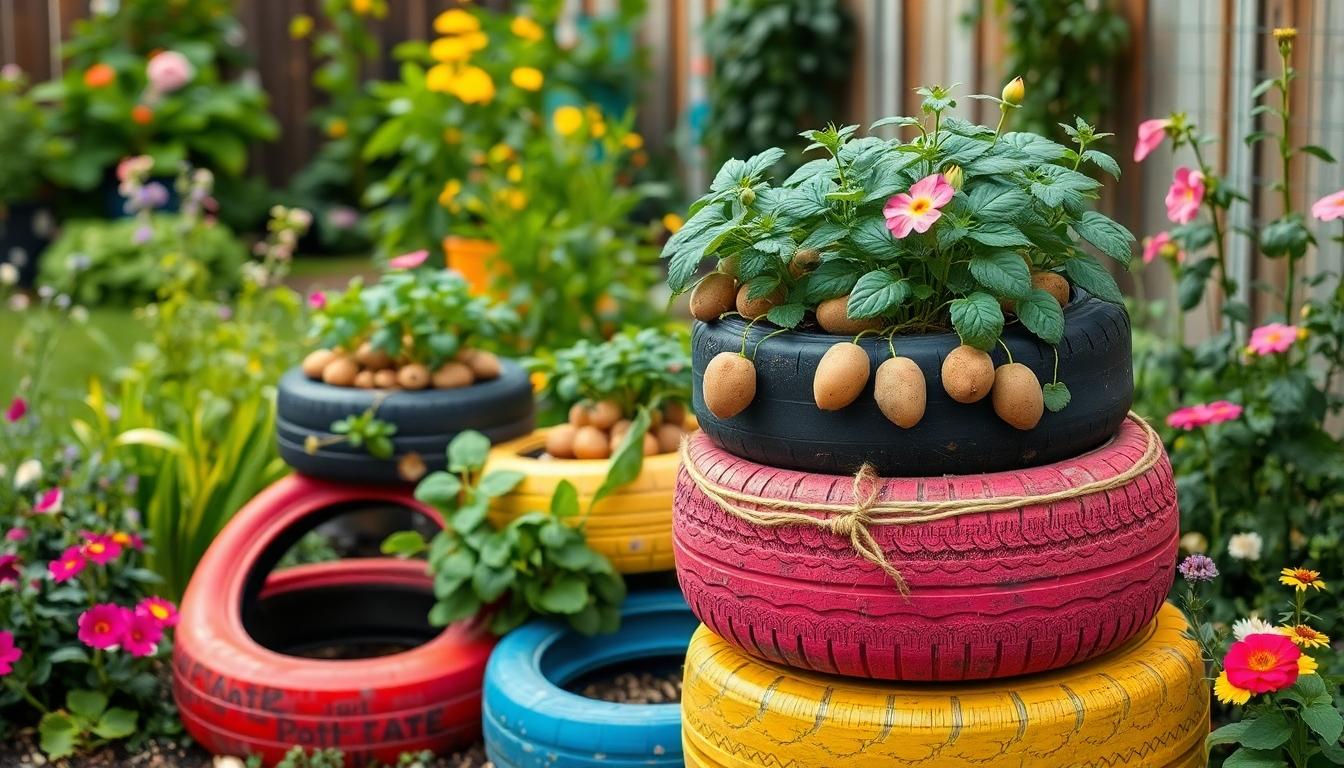
Vertical Stacking for Space Maximization
Vertical gardening with tires offers an excellent solution for gardeners with limited space. We recommend stacking up to three tires as your potato plants grow, which allows potatoes to form all the way up the stack. Starting with a single tire, you can add additional tires once plants reach about 6 inches tall, filling each new level with soil or compost. This vertical approach not only maximizes your growing area but also significantly increases your overall potato yield in the same footprint.
Decorative Enhancements
Transform plain black tires into attractive garden features with simple decorative touches. Painting your tires with vibrant, weather-resistant colors can add visual interest to your garden space while complementing your existing industry design. Alternatively, wrapping the outer surfaces with natural twine creates a more rustic, organic appearance that blends beautifully with garden surroundings. These aesthetic improvements make your tire potato garden both functional and visually appealing.
Nutrient-Rich Soil Combinations
Creating the perfect growing medium can dramatically improve your potato harvest. We suggest incorporating a mixture of coffee grounds, leaf mold, and fresh lawn clippings into your standard soil and compost blend. Coffee grounds add nitrogen while improving soil structure, leaf mold enhances moisture retention, and lawn clippings provide additional nutrients as they decompose. This diverse organic mix creates an ideal environment for potatoes to develop throughout your tire tower.
Worm Farm Integration
Elevate your tire potato garden by incorporating worm farming principles into your design. Adding red wriggler worms to your tire setup creates a living network that continuously enhances soil fertility. The worms naturally aerate the soil while producing nutrient-rich castings that feed your potato plants. This integration attracts beneficial earthworms from the surrounding soil, creating a self-sustaining system that improves with each growing season.
Companion Planting Arrangements
Maximize the growing space around your tire towers with strategic companion planting. Low-growing herbs like thyme and oregano planted around the base of your tire stack can deter pests while utilizing otherwise unused space. Nasturtiums cascading down the sides of your tires add both ornamental value and pest-repelling properties. These thoughtful planting combinations create a productive microecosystem while improving the overall appearance of your potato garden.
Comparing Tire Growing to Traditional Potato Methods
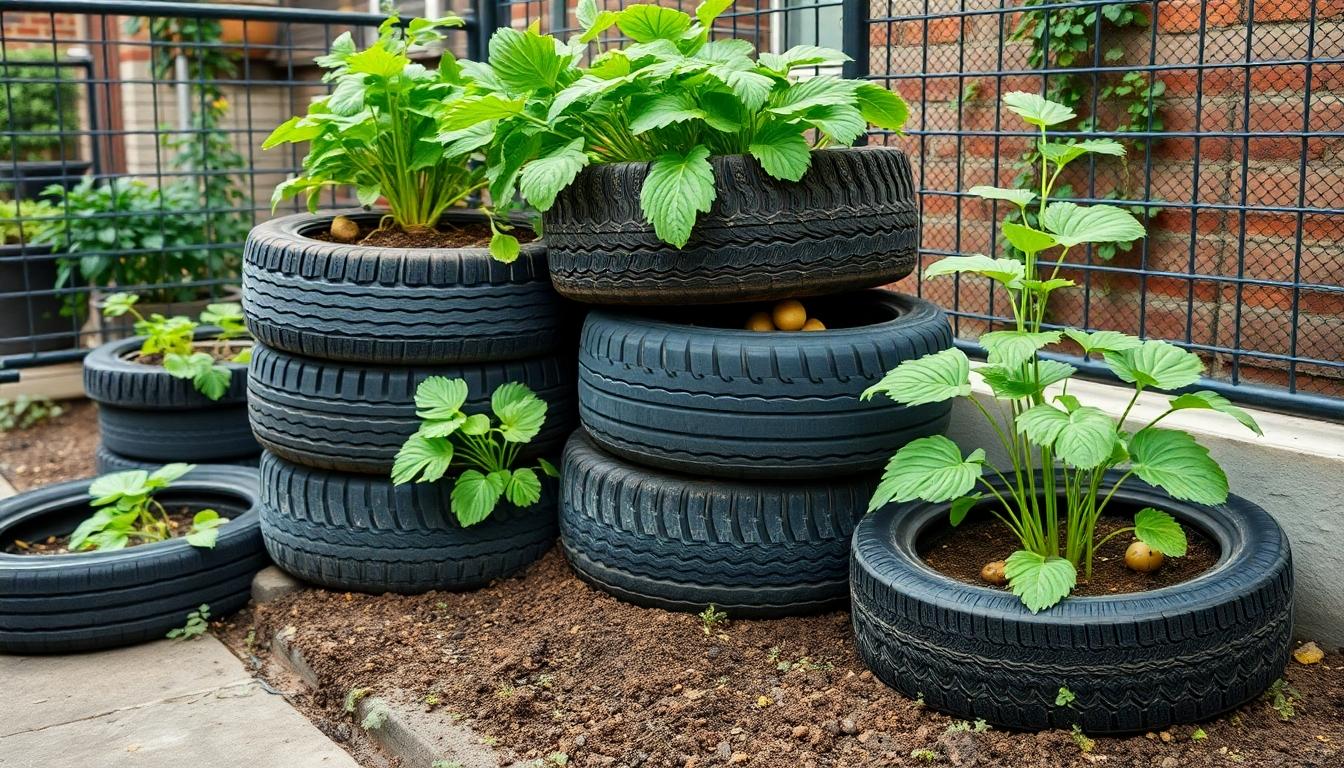
Space Efficiency and Setup
Tire growing maximizes vertical space in ways traditional methods simply can’t match. When using tires, we start by placing seed potatoes in the bottom tire with soil, then add additional tires as plants grow 2-6 inches tall, filling each new tier while leaving some foliage exposed. This vertical stacking technique makes tire growing perfect for urban gardens or small spaces where ground area is limited. Traditional methods require more horizontal space, with seed potatoes planted in trenches and covered with soil in rows across your garden plot.
Cost Considerations
Growing potatoes in tires offers impressive cost savings compared to conventional methods. Old tires can often be sourced for free from auto shops or recycling centers, creating an essentially zero-cost container system. Traditional potato growing typically involves purchasing specialized tools for trenching and hilling, plus the expense of preparing larger soil areas. Both methods require similar investments in seed potatoes and soil amendments, but the tire method needs less total soil volume due to its concentrated growing area.
Maintenance Requirements
Traditional potato growing generally demands less ongoing maintenance throughout the growing season. With tire growing, you’ll need to monitor plant growth carefully and add new tires at the right time, which requires more hands-on attention. Stacking tires and adding soil needs to be done precisely when plants reach 2-6 inches above the current soil level to maximize tuber production. By contrast, traditional methods mainly require occasional hilling of soil around plants and standard watering routines without the need for structural adjustments.
Yield Comparison
| Feature | Growing Potatoes in Tires | Traditional Methods |
|---|---|---|
| Space Efficiency | Highly efficient for small spaces | Requires more ground area |
| Cost | Free or low-cost (using old tires) | Higher initial investment in tools and space preparation |
| Maintenance | Higher maintenance (requires stacking tires as plants grow) | Lower maintenance (simple hilling process) |
| Yield | Variable depending on setup | Generally higher in optimal conditions |
Traditional methods typically produce higher overall yields when space isn’t a limiting factor. A traditional garden row can accommodate more potato plants across a larger area, potentially resulting in more total potatoes. Tire growing concentrates production in a smaller footprint, often producing more potatoes per square foot but fewer total potatoes than a large traditional plot. The tire method’s yield advantage comes from its ability to encourage potato formation along a greater length of buried stem within the vertical structure.
Environmental Considerations
Tire growing recycles materials that would otherwise contribute to landfill waste. Using old tires gives these products a second life while creating productive growing containers. The dark rubber of tires also absorbs heat, potentially extending growing seasons in cooler climates. Traditional methods avoid potential concerns about chemical leaching from rubber but require more land disturbance. Both approaches can be implemented with organic growing practices, though tire growing offers better protection from soil-borne pests and diseases through separation from ground soil.
Conclusion: Maximizing Your Potato Yield with the Tire Method
Growing potatoes in tires represents an ingenious solution for gardeners with space limitations or those looking to simplify their potato cultivation. We’ve seen how this method offers many advantages from cost savings and environmental benefits to easier harvesting and extended growing seasons.
Whether you’re a beginner gardener or a seasoned homesteader this vertical growing technique merits consideration for your next potato crop. With minimal investment and some basic supplies you can create a productive potato tower that maximizes yield while minimizing effort.
Ready to give tire potato growing a try? The stacked tire method might just revolutionize how you grow this versatile staple crop in your garden while helping you achieve impressive harvests in even the smallest spaces.
Frequently Asked Questions
Is growing potatoes in tires safe for consumption?
Yes, growing potatoes in tires is generally considered safe. While there have been concerns about chemicals leaching from tires, research indicates that properly weathered tires pose minimal risk to food crops. To minimize any potential issues, use tires that have been exposed to the elements for some time rather than brand new ones. The benefits of recycling old tires and the practical advantages of this growing method typically outweigh the marginal concerns.
How many potatoes can I expect to harvest from a tire tower?
A single 3-5 tire potato tower can yield approximately 25-50 pounds of potatoes, depending on variety, growing conditions, and care. This method typically produces 2-3 times more potatoes than traditional in-ground growing in the same footprint. The vertical growth allows potato plants to develop tubers along a greater length of stem, significantly increasing yield in limited space.
When is the best time to plant potatoes in tires?
Plant potatoes in tires about 2-3 weeks before your region’s last expected frost date when soil temperatures reach at least 45°F (7°C). In most North American regions, this falls between early March and late May. The heat-absorbing quality of black rubber tires can extend your growing season by warming the soil faster than traditional gardens, potentially allowing for earlier planting in cooler climates.
How often should I water potatoes growing in tires?
Water tire potato gardens when the top 1-2 inches of soil feels dry, typically 1-2 times per week depending on your climate. Consistent moisture is essential, but avoid waterlogging as excessive moisture can cause rot. Tire towers may require more frequent watering than in-ground gardens during hot weather as they can dry out faster, but their vertical design generally improves water efficiency overall.
Do I need to add fertilizer to potatoes growing in tires?
Yes, fertilizing is beneficial. Start with compost-rich soil when planting, then apply a balanced organic fertilizer (like 5-10-10) when plants reach 6 inches tall. A second application when flowering begins supports tuber development. Avoid high-nitrogen fertilizers as these promote foliage at the expense of potato production. The confined growing space of tires means nutrients deplete faster than in-ground gardens.
How do I prevent pests in my tire potato garden?
Maintain good air circulation between plants and inspect regularly for common pests like Colorado potato beetles and aphids. The elevated nature of tire towers naturally reduces problems with soil-dwelling pests like wireworms. Apply organic insecticidal soap for minor infestations or introduce beneficial insects like ladybugs. The modular design makes it easier to isolate and treat specific sections if pest problems occur.
Can I reuse the soil from tire potato towers next season?
Yes, but with proper preparation. The soil should be refreshed with compost (about 25% new material) and allowed to rest over winter to replenish nutrients. Potatoes deplete specific nutrients, so crop rotation is advisable—use the soil for non-solanaceous crops the following year. Alternatively, you can mix the used soil with fresh garden soil and amendments to restore fertility for growing potatoes again.
What potato varieties work best in tire towers?
Indeterminate or late-season varieties like Russet, German Butterball, and Kennebec perform exceptionally well in tire towers as they continue producing tubers along the stem as it grows. Early varieties like Yukon Gold and Red Norland also work but may not take full advantage of the vertical growing space. Disease-resistant varieties are particularly valuable as the contained environment can sometimes increase humidity.

